Pollux is the brightest star in the constellation of Gemini. It is an orange-hued evolved giant star, and also the closest giant star to the sun at a distance of only 34 light-years.
Key Facts & Summary
- Pollux is the 18th brightest star in the night sky and it also hosts an exoplanet designated Pollux b, later named Thestias.
- The existence of Thestias was confirmed in 2006. The planet orbits Pollux once every 590 days.
- Thestias mass is speculated to be around 2.3 times that of Jupiter. The exoplanet orbits Pollux at a distance of about 1.64 AU in a nearly circular orbit.
- Pollux is a giant star of spectral type K0 III. The star’s spectrum served as one of the stable anchor points by which other stars were classified.
- Pollux has an apparent magnitude of 1.14. It is easily visible with the naked eye.
- Pollux has around 1.91 solar masses, almost twice than that of the Sun and about nine times its radius.
- Pollux has an average temperature of around 4.666 Kelvins, a bit cooler than our sun.
- The radial velocity of Pollux is estimated to be around + 3.23 km / 2 mi per second.
- Measurements conducted by the Hipparcos astrometry satellite estimate that Pollux is around 33.78 light-years / 10.36 parsecs away from the sun.
- Recent observations revealed that Pollux has a surface magnetic field strength below 1 Gauss. This is one of the weakest magnetic fields ever discovered in a star.
- This weak magnetic field points out the fact that Pollux might have been an Ap star with a much stronger magnetic field.
- Though the star displays small amplitude radial velocity variations, it is not photometrically variable.
- Pollux is much brighter than its close neighbor Castor α Geminorum.
Pollux along with Castor, are the two main guideposts for the asterism nicknamed the Twins. Though Pollux is brighter than Castor, it is Castor who is designated the Alpha Geminorum. This might suggest that one or maybe both stars have altered in brightness since their designation around 300 years ago.
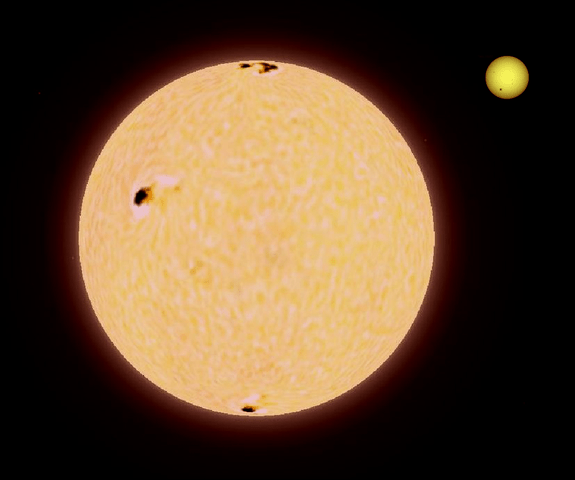
The name Pollux comes from a legend from both the Greek and Latin – Roman cultures. Pollux and Castor were twins and they were called Dioscuri in Greek, and the Gemini in Latin. The twins would help sailors in their time of need.
In Greek mythology, Pollux was one of two brothers who appeared prominently among Jason’s Argonauts. They were the sons of Leda, the queen of Sparta.
They had different fathers though, Castor had a mortal father and was thus mortal himself, while Pollux was the son of Zeus and was thus immortal. They also had a sister, the famous Helen of Troy.
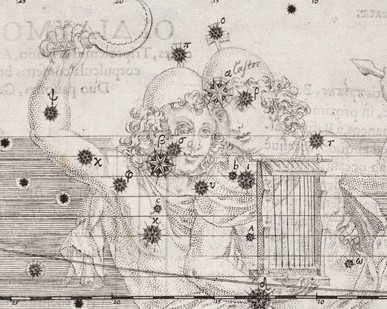
In a battle, Castor supposedly died and Pollux begged Zeus to let him die and be reunited with his brother. Zeus couldn’t grant his wish since he was immortal.
He decreed that Pollux would stay in Olympus for some periods of time while also visit his brother in the underworld. Since Zeus was admiring Pollux’s brotherly love, he honored it and placed their constellation in the sky as a remembrance.
Formation
Pollux formed around 724 million years ago, most likely from a cloud of dust and gas. The gravity pulled together the swirling gas and dust to make the star that we see today as the brightest of the Gemini constellation.
Though in the beginning, it is heavily implied that Pollux started off as a main-sequence star of spectral type A. It eventually exhausted its supply of hydrogen and evolved into an orange giant.
Distance, Size, and Mass
Measurements conducted by the Hipparcos astrometry satellite estimate that Pollux is around 33.78 light-years / 10.36 parsecs away from the Sun but other measurements put it at 34 light-years away. Around the same distance as the red giant Arcturus, the brightest star in the constellation of Boötes.
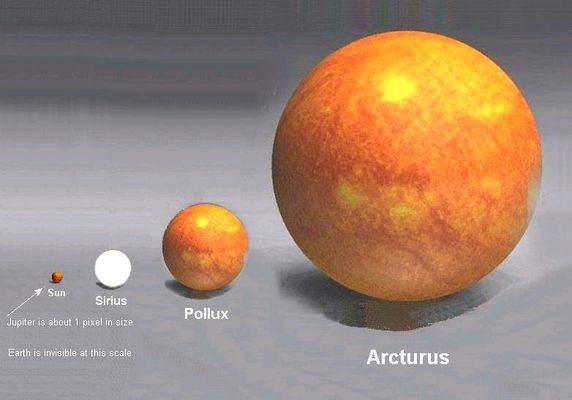
Being an evolved giant orange star, Pollux is considerably larger than the sun. It has almost 9 times the sun’s radius – 8.8 solar radii, almost eighteen times its diameter and around 2 times its mass – 1.91 solar masses.
Other Characteristics
It was suspected that Pollux might be a variable star. It indeed showed some small amplitude variations in its radial velocity, but photometrically, it wasn’t variable. Pollux’s abundance of elements – metallicity – is uncertain. Some estimates suggest it ranges from 85% to 155% of the Sun’s abundance.
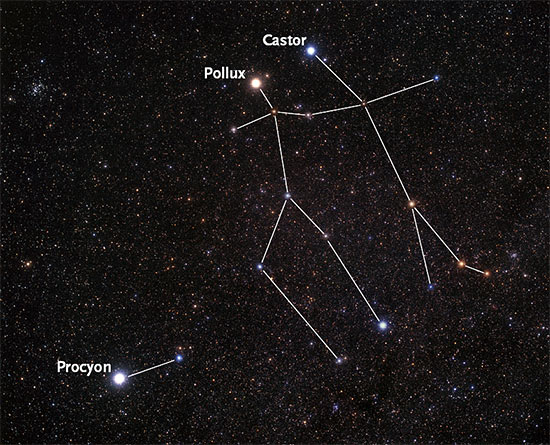
Pollux shines 48 times brighter than our sun – 48 solar luminosities, being the brightest star in its constellation. It is, however, cooler than our sun, with its outer envelope at temperatures around 4.666 K. Pollux’s magnetic field has been studied and it displays a very weak – below 1 Gauss magnetic field strength. This is the weakest ever discovered in a star.
Planetary System
The existence of an exoplanet around Pollux was suspected since 1993, however, it was only in 2006 when the planet’s existence was finally confirmed.
Pollux b or Thestias, is a planet with an estimated mass of at least 2.3 times that of Jupiter – thus it is likely a gas giant. The exoplanet orbits Pollux once every 590 days at a distance of 1.64 AU in a nearly circular orbit. Thestias is the patronym of Leda, a daughter of Thestius – one of the kings of the Pleuronians in Aetolia.
The exoplanet was named through public voting and suggestions. In 2015 the winning name was Thestias though it could have been Leda – Pollux’s mother in Greek and Roman mythology – however, the name was already attributed to an asteroid and to one of Jupiter’s satellites.
Location
Pollux is located in the zodiac constellation Gemini. The star is most prominent in the winter sky in northern latitudes. There are many interesting deep sky objects in Gemini.
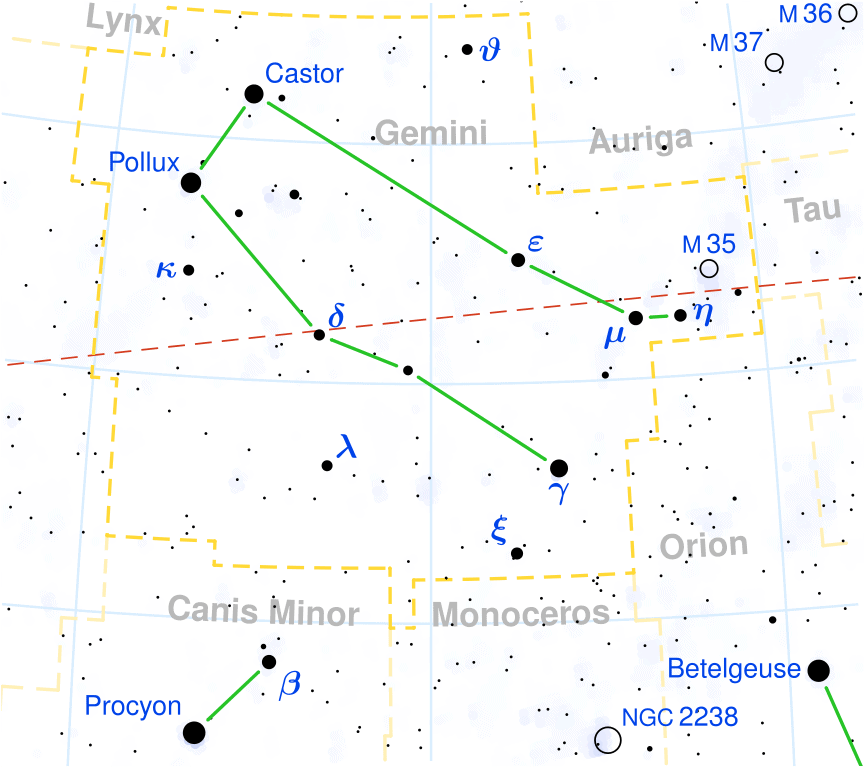
Pollux and Castor are around 18 light-years apart from one another. Probably the best month to observe the constellation is in February – this is when it is the most prominent.
The Future
Based on Pollux’s mass, it is not massive enough to explode as a supernova. Most scientists believe that the star will end its life by expelling its outer layers to form a planetary nebula, leaving behind a compact white dwarf.
Did you know?
- Pollux, and by extension Castor, are sometimes identified with Apollo and Hercules or even with the founders of Rome – the brothers Romulus and Remus.
- Many cultures associate Pollux and Castor as twins. However, in India, they were the Horsemen, and in Phoenicia, they were two gazelles or two kid-goats.
- In China, the stars were associated with Yin and Yang. Most cultures represent the stars as two of something.
- Though they appear similar in brightness and are often referred to as twins, Pollux is a single star while Castor is a star system consisting of six.
- Pollux along with Procyon, Sirius, Rigel, Aldebaran, and Capella form the Winter Hexagon. This is a large asterism that dominates the evening sky during the northern hemisphere winter.
- Among the stars of the Gemini constellation, Pollux is the only one listed among the 58 selected stars for navigation.
- The Chinese named Pollux the Third Star of North River – which is an asterism formed by Pollux, Castor and Rho Geminorum.
- The Babylonians named the star Mu-sir-kes-da – the Yoke of the Inclosure – they saw the star as part of an asterism called Mash-mashu-arku – the Eastern One of the Twins, while the Assyrians called Pollux and Castor Mas-mas – twins.
- The constellation of Gemini is the northernmost of the zodiacal constellations and among the brightest.
Sources:
Image source:
- https://upload.wikimedia.org/wikipedia/commons/thumb/6/61/Pollux-Sun_comparison.png/575px-Pollux-Sun_comparison.png
- https://en.es-static.us/upl/2009/06/gemni_twins-bayer.jpeg
- https://en.es-static.us/upl/2009/06/sun-sirus-pollux-arcturus.jpeg
- https://s22380.pcdn.co/wp-content/uploads/Gemini-and-Procyon-Fujii_550px.jpg
- https://upload.wikimedia.org/wikipedia/commons/thumb/b/bf/Gemini_constellation_map.svg/865px-Gemini_constellation_map.svg.png
